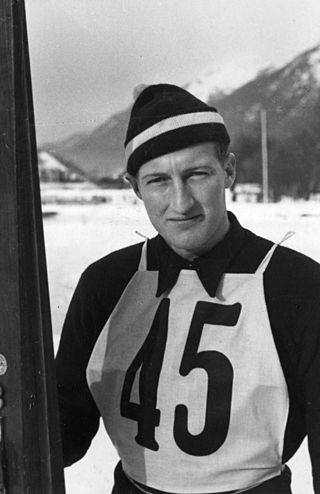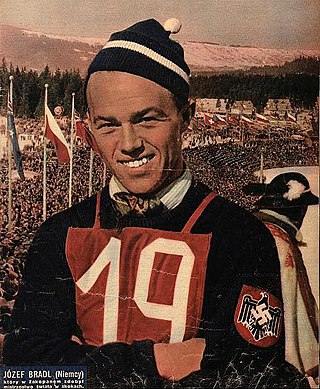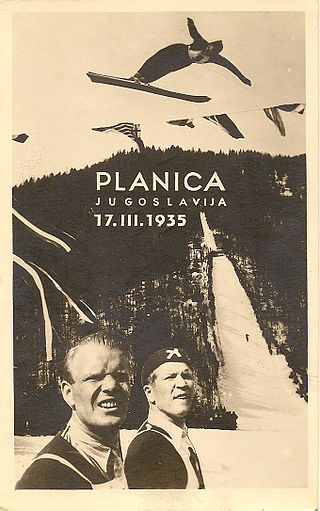
Heini-Klopfer-Skiflugschanze is a ski flying hill in Oberstdorf, Germany. It was opened in 1950, and was later renamed after its architect, Heini Klopfer. A total of 21 world records have been set on the hill. The venue should not be confused with the Schattenberg ski jumping hill, also in Oberstdorf, about 7 kilometres (4.3 mi) to the north.

Reidar Andersen was a Norwegian ski jumper who competed in the 1930s.

Josef "Sepp" / "Bubi" Bradl was an Austrian ski jumper who competed during the 1930s and 1950s. He was born in Wasserburg am Inn, Bavaria.

Letalnica bratov Gorišek is one of the two largest ski flying hills in the world and the biggest of eight hills located at the Planica Nordic Centre in Planica, Slovenia.

The FIS Ski Flying World Ski Championships 1985 was held between 16 and 17 March in Planica, Yugoslavia. This was the third record time hosting world championships after 1972 and 1979.

The FIS Ski Flying World Ski Championships 1994 took place on 20 March 1994 in Planica, Slovenia for the record fourth time. It also counted for World Cup. They previously hosted the championships as being part of Yugoslavia in 1972, 1979 and 1985. This was the first large international sporting event in Slovenia after they declared its independence in 1991 following the Ten-Day War.

Bloudkova velikanka, also Bloudek-Rožmanova velikanka, is a large ski jumping hill in Planica, Slovenia, originally opened in 1934. In 2001 the hill collapsed and was completely rebuilt in 2012. A new normal hill (HS102) was also built next to Bloudkova velikanka in 2012, replacing the old K90 hill. A total of ten world records were set at the venue in the 1930s and 1940s.
Rudi Gering (1917–1998) was a German ski jumper. He was born in Thüringen in Germany and died somewhere in Bavaria.
Paul Krauß was a German ski jumper.

Planica 1991 was a two day ski flying competition part of 1990/91 World Cup season, held from 23–24 March 1991 in Planica, SR Slovenia, Yugoslavia. Total of 80,000 people have gathered in three days.

Planica 1987 was a two day ski flying competition part of 1986/87 World Cup season, held from 14 to 15 March 1987 in Planica, SR Slovenia, Yugoslavia. Circa 100,000 people in total has gathered in three days.
Heinrich Palme was a German ski jumper.

Planica 1934 refers to a ski jumping event with national championships held on 4 February 1934 and the first international event on 25 March 1934 in Planica, Drava Banovina, Kingdom of Yugoslavia.

Planica 1936 was a ski jumping event, considered as the birth of ski flying, held on 15 March 1936 in Planica, Drava Banovina, Yugoslavia. Total of 16,000 people gathered to watch the competition.

Planica 1935 was a ski jumping event held on 17 March 1935 in Planica, Drava Banovina, Kingdom of Yugoslavia. Total of 12,500 people have gathered in the competition.

Planica 1938 was a ski flying study week, allowed only in study purposes, with main competition held on 16 March 1938 in Planica, Drava Banovina, Kingdom of Yugoslavia.

Planica 1940 was a ski flying study week, allowed only in study purposes, with main competition held on 10 March 1940 in Planica, Drava Banovina, Kingdom of Yugoslavia. Over 6,000 people has gathered.

Planica 1947 was a ski flying week, allowed only in study purposes, competition held on 24 March 1947 in Planica, PR Slovenia, FPR Yugoslavia. This was the first post WWII competition with total over 25,000 people.

Planica 1948 was an International ski flying week competition held from 14—17 March 1948 in Planica, PR Slovenia, FPR Yugoslavia. Over 20,000 people has gathered in total. The best jump counted as final result.










